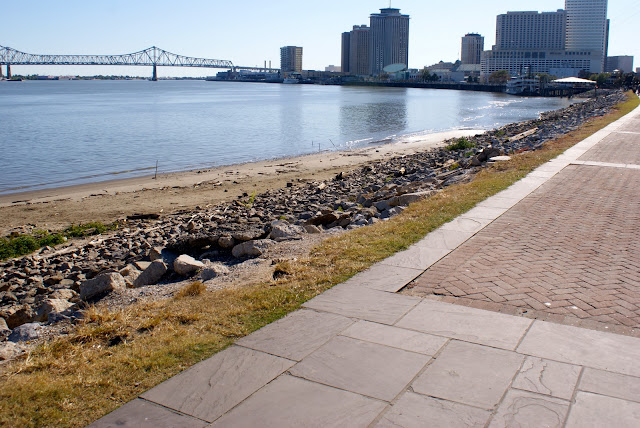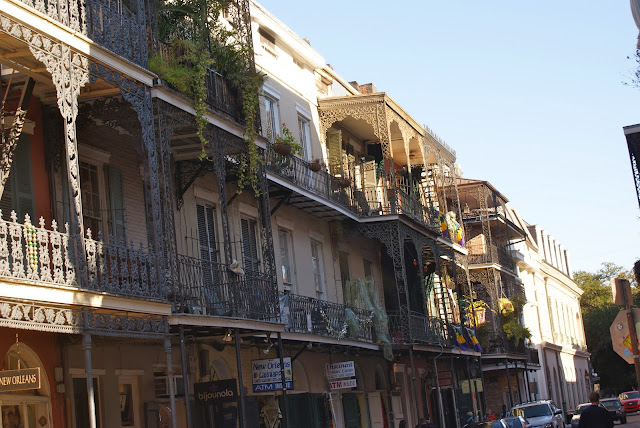Well, I wish I was in New Orleans
I can see it in my dreams
Arm-in-Arm Down Burgundy
A bottle, and my friends and me
Hoist up a few tall cool ones
Play some pool and listen to that
Tenor Saxophone calling me home
And I can hear the band begin
"When the Saints go Marching In"
By the whiskers on my chin,
New Orleans, I'll be there
What a city! What a weekend (actually 5 nights and 4 full days). A city of art, and beauty, and culture, and literature, and the best side of the human race, and also a city of corruption, and drunks, and tackiness, and sin, and poverty and crime, and the worst side of the human race. Our best analogy is, of all things, Bourbon Street in the French Quarter. You walk into Bourbon Street off of Canal; Canal is kind of like Woodward Avenue in the 60s; a wide boulevard (the widest in the country) with lots of restaurants, hotels, and retail. The moment you turn onto Bourbon Street it's like you got on one of the boats for "It's a Small World", except it's clearly not a ride for kids. You wander down Bourbon Street for 6 or 8 blocks (i.e. the block with the last bars on it), wall to wall people, bars, restaurants, strip joints, tacky gift shops, bands playing every kind of music known to man at top volume, with something for every possible vice you can imagine (and frankly some things we hadn't imagined), and then after 6 or 8 blocks it's like you get off the boat and you are in a beautiful quiet residential area full of interesting architecture.
And Bourbon Street, while the most famous and "touristy", is really not representative of the city or even of the French Quarter, where Bourbon is located.
So where to start this post? We got in on a Thursday night; fairly late, and did the obligatory walk down Bourbon, but we got off as soon as we could and had dinner at a restaurant on one of the side streets in the French Quarter. It was fairly representative of what we would find; nice atmosphere; jazz decorations, a tv for sports, and a menu that, if you are kosher and/or vegetarian, is somewhat challenging.
The food was fine, and the local beer that Alan had (Abita) was great; but the best part of this meal, and of most meals we ate, was the conversation with the waitstaff. The waitstaff love to talk, to hear about you, to tell their stories, and to thank you for coming to their city. For example, in this restaurant, our waiter was a young man going to school to be a pharmacist; he had very high grades and great offers, and continually talked about how blessed he was. It was only after we asked that he told us his Katrina story; he and his family lost everything. This was a theme that would repeat itself throughout the weekend with waitstaff, cabbies, people on the street, standing in line, walking in neighborhoods, where ever; we talked to a lot of people because this is the friendliest place we have been to yet; most of them had lost everything or knew people who lost everything in Katrina (rich and poor, black and white; the poor were hit the hardest but all seemed to have been hit) and yet no one was sad, or had anything bad to say about the city (although they had plenty of bitterness, still, aimed at the Bush administration) and they all loved, and we mean LOVED, their city. We have talked to a lot of people in a lot of places who are proud of their city, or love living in their city, but we have never seen such a deep, deep attachment to a place as was the case in New Orleans.
On Friday we took a three hour city tour to gain some familiarity about the city. We were on a small tour bus with about 30 tourists and the tour guide; it started at 8:30 in the morning, and the last group he picked up, a group of 8 people in their 30s (who based on their conversations were parents of pre-teenage kids left at home for the party weekend), boarded the bus with beer cans in hand, and proceeded to drink and party during the entire tour. The city takes all kinds, that's for sure. In any event, the tour was worthwhile; we stopped at several places we'll cover later in the post, but included the following, among others:
 |
| Our tour guide Jason explaining the process of removal; this tomb has had its decorative panel removed in preparation for moving the remains to the bottom |
 |
| One of the beautiful homes in the Garden District; we returned here on Saturday |
 |
| City Park; we came back here Sunday. When our 8 friends ran out of beer at this stop, one of them ran to a gas station to replenish |
 |
| Home in the Ninth District. More on this later. |
After the tour, we walked through the French Market, at the base of the French Quarter, and browsed through their flea market and had a nice lunch of "Salmon Po'Boys" (it's as close as we will ever come to a Po'Boy, which actually sounds pretty good if you are into that non-Kosher meat type of thing). French market is centuries old, as is most of the French Quarter, but has been renovated lately
 |
| Walking through the French Market |
 |
| Music is everywhere, as are outdoor cafes, coffee houses, and bars |
We spent the afternoon walking through the French Quarter. We started at Jackson Square, the heart of the French Quarter, which is where France signed over Louisiana to the United States.
 |
| There are artists and street performers on all four sides of the square and there are "Chic" shops surrounding two sides |
 |
| View of the Mississippi across from the Square |
 |
| Brass Band Busking in front of the Square |
 |
| One of many characters in the French Quarter dancing to the Brass Band |
 |
| We were in the Square on 11/11/11; a lot of people get married that day; they got married at a park overlooking the Square |
 |
| View of the Square from the park across the way |
All that walking made us hungry, and Cafe' du Monde is right at the Square, so we stopped for a truly traditional break; chicory coffee and beignets (I believe it translates into English as "Fried Elephant Ears"). That's about all that this iconic place serves (it's been there for over a century and is open 24/7) and everyone stops by for a sample:
We then wandered around the French Quarter for the rest of the afternoon. If you stay off of Bourbon, the French Quarter (which is the oldest part of the city) is charming and fun. It's filled with antique stores, bookstores, clothing stores, and other fun places to browse. The architecture is great. A lot of it is Spanish; the French gave New Orleans to the Spanish in the 1760s (part of a deal with Britain to compensate Spain for losing Florida) and didn't get it back until 1803, when they immediately flipped it to the United States as part of the Louisiana Purchase.
Royal Street, in particular, has great Buskers; New Orleans has talent like only a few other cities in the Country. Here is a video of a few of our favorites (we really love the guy with the washboard)- click on the link to see it: https://picasaweb.google.com/104736309657922602886/NewOrleansBuskers
Every evening we went to clubs and bars and heard great music; we'll talk about that in part two of this post.
On Saturday we took the St. Charles Trolly and went to the World War II Museum, the Garden District, and Magazine Street, which is kind of like Royal Oak or Birmingham on Steroids and goes for over 6 miles.
The World War II Museum was located in New Orleans because the transport boats that Eisenhower claimed "won the war" were designed and manufactured in New Orleans (think the opening scene in "Saving Private Ryan". The museum focuses most of its efforts on D Day but does have a lot of material before and after, and also some on the Pacific Theater. One could easily spend a whole day there, but we only spent a couple of hours.
We then wandered around the Garden District for several hours; it is an area of beautiful, large houses, built by the American elite in the 1800s to separate themselves from the Creole elite. Many celebrities, authors, and artists have houses there including John Goodman, Ann Rice, Sandra Bullock, Nicholas Cage and others (a lot of movies are made in New Orleans; one person told us that there are 7 in production in Hollywood right now and 33 in New Orleans).
 |
| This beaut is for sale for only 12.5MM |
 |
| A lot of grill work |
 |
| Original Tract Housing, called the 7 sisters because they all are the same |
 |
| The Mysterious Case of Benjamin Button was filmed here |
 |
| Dual Staircase allows a woman with a large hoop skirt to go down one and her escort to go down the other |
During our walk a guy walking his dog stopped us and asked us where we were from; we stood on the street talking for over 20 minutes while he told us his life story and how much he loved the city; he also thanked us for visiting.
We were hungry so we walked the few blocks to Magazine Street and stopped at an outdoor cafe for a quick bite
We then strolled down Magazine Street for a while, about a mile and a half, and we came to a small park where they were holding a "Magazine Street Blues Festival". Needless to say, the atmosphere was friendly and welcoming and the music was wonderful:
We then headed back to the French Quarter to hit some clubs.
We did so much in New Orleans, that we think we will break this into two posts; tomorrow we will finish with City Park, Algiers, River Walk, Laura Plantation..... and all of the terrific, wonderful, first rate music music music that we heard every night!
I'll drink you under the table
Be red nose go for walks
The old haunts what I wants
Is red beans and rice
And wear the dress I like so well
Meet me at the old saloon
Make sure there's a Dixie moon
New Orleans I'll be there
And deal the cards roll the dice
If it ain't that ole Chuck E. Weiss
And Clayborn Avenue me and you
Sam Jones and all
And I wish I was in New Orleans
I can see it in my dreams
Arm in arm down Burgundy
A bottle and my friends and me
New Orleans I'll be there
Be red nose go for walks
The old haunts what I wants
Is red beans and rice
And wear the dress I like so well
Meet me at the old saloon
Make sure there's a Dixie moon
New Orleans I'll be there
And deal the cards roll the dice
If it ain't that ole Chuck E. Weiss
And Clayborn Avenue me and you
Sam Jones and all
And I wish I was in New Orleans
I can see it in my dreams
Arm in arm down Burgundy
A bottle and my friends and me
New Orleans I'll be there
(Tom Waits)
















































No comments:
Post a Comment